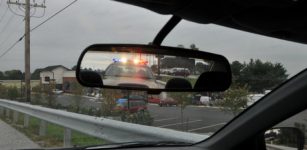NSW Police Pursuit Results in Another Tragic Death

NSW police have engaged in the pursuit of a vehicle yet again, and this time the chase has led to the tragic death of a teen. Around 2 am last Friday, police tried to stop a ute in Kempsey. But when the driver refused to pull over, the officers chased the youth 50 kilometres up the Pacific Highway.
Police tailed the teenager as far as Macksville on the NSW mid-north coast. As the boy passed over the Macksville Bridge, just north of the town, he collided head on with a B-double truck travelling in the opposite direction.
The teen’s vehicle was crushed beyond recognition and he died at the scene. The truck driver was not injured, but he was taken to the local hospital for mandatory testing.
Police won’t reveal how fast they were driving
A critical incident team is currently investigating the crash that occurred along the notoriously dangerous stretch of road just north of Macksville. Police wouldn’t comment on why they attempted to pull the teen over, or inform of the speeds reached during the pursuit.
“Those matters will be subject to the coroner’s investigation. The critical incident team will be gathering that information.” NSW police superintendent Paul Fehon told the ABC. He added that the situation was not only tragic for the police and emergency services involved, “but more so for the family.”
Other states have banned high-speed chases
But this fatal incident is not unique when it comes to the response of police to drivers that flee. High-speed pursuits carried out by the various state police forces have resulted in numerous deaths for decades now.
These road fatalities have led to states such as Victoria, Tasmania and Queensland banning high-speed police chases.
The Victoria police pursuit policy was amended in June 2015, so that police can only chase vehicles under exceptional circumstances. These include when it is deemed necessary to prevent serious risk to public health and safety, or if a criminal offence has been committed that involves serious injury to a person.
At the time of the amendment, Victorian police assistant commissioner Robert Hill said there are few incidents where a fleeing driver stops, once they’ve started to flee police, so pursuing them only exacerbates the situation.
The assistant commissioner said he was sure the no-pursuit policy would save lives, and that it didn’t mean offenders would get away with crimes, as they would almost always be apprehended at a later time.
In 1999, Tasmania passed a ban on high-speed pursuits for minor offences – such as traffic violations – which has resulted in deaths and injuries caused by police chases almost being eliminated. And in Queensland a similar 2012 ban has had the same effect.
NSW refuses to follow suit
However, NSW police continue their dangerous practice of chasing vehicles at high-speeds. This is despite legal and community groups calling on them to change their policy when it comes to these pursuits.
There was public outcry in February last year after a high-speed pursuit in Sydney’s Marayong left three people dead and two injured. Officers attempted to stop a car that was seen driving with its lights off. After the vehicle took off at high-speed, police gave chase, which resulted in the car hitting a power pole just moments later.
Road safety expert John Lambert told the ABC in January last year, that statistically NSW pursues more vehicles than almost any other jurisdiction. The state conducts “a very high level of pursuits,” he said and added that the only jurisdiction that has a higher pursuit rate is the Northern Territory.
NSW Greens MLC David Shoebridge has criticised the state’s policy of pursuing vehicles for minor traffic infringements. He stated that NSW police “are addicted to high-speed police chases,” and he thinks “it’s going to require intervention from the minister to fix it.”
NSW police were tasked with conducting a review of their Safe Driving Policy seven years ago, with the aim of improving road safety. It was announced in the Police Monthly June 2016 that “the Safe Driving Policy has been revised.” But it seems the new policy has never been released to the public.
Redfern Legal Centre senior solicitor David Porter speculated in January last year that NSW police had updated their policy, but he couldn’t understand why it hadn’t been released.
An exception to the rule
However, as we reported in a previous blog, NSW police don’t always carry on with their high-speed pursuits. On January 10 this year, police initiated a pursuit of a car in Mount Riverview, but subsequently abandoned the chase in the interests of public safety.
The vehicle was later spotted by police that same day in Campbelltown. The driver got out of the car and tried to flee, but he was apprehended by the officers.
The 20 year-old-man, who was already wanted by police, was charged with a number of offences, including police pursuit (Skye’s law) and break, enter and steal.
The officers’ decision to suspend the pursuit and apprehend the suspect later – mirroring the Victorian police pursuit policy – was praised by police associations and public safety groups.
Skye’s law
The offence of police pursuit, also known as Skye’s law, is outlined in section 51B of the NSW Crimes Act 1900.
A driver is guilty of the offence if they were aware, ought reasonably to have known, or had reasonable grounds to suspect that police were pursuing them, but they refused to stop and drove recklessly, at high-speed or in a dangerous manner.
The offence carries a maximum penalty of three years’ imprisonment, or five years’ for a second or later offence.
The law was named after Skye Sassine. She was only 19 months old, when William Ngati, who was fleeing a police pursuit, crashed into the back of her parents’ car, killing her on New Year’s Eve, 2009. Her tragic death led to tougher penalties against those that lead police on high-speed chases.
High-speed pursuits need to stop
However, while Skye’s law does result in longer prison terms for those involved in police pursuits, it seems it’s hardly a deterrent at the moment that someone decides to flee a police vehicle, as these chases continue to happen.
But it has been shown in states across the country where no-pursuit policies are implemented that these result is less road fatalities.
So until NSW police change their policy of pursuing vehicles at high-speeds, there’s always the chance that another young child could become the victim of a fatal accident.
This child would be another casualty of a flawed policy that sees police trying to catch an offender immediately, rather than apprehending them at a later time, when there’s less of a threat to the general public.
Going to court for a traffic offence?
If you are going to court for a traffic offence, call or email Sydney Criminal Lawyers anytime to arrange a free first consultation with an experienced, specialist traffic lawyer who will accurately advise you of your options, the best way forward, and fight for the optimal outcome in your specific situation.







